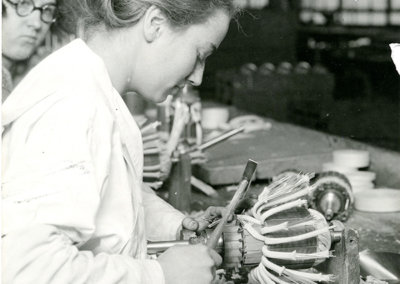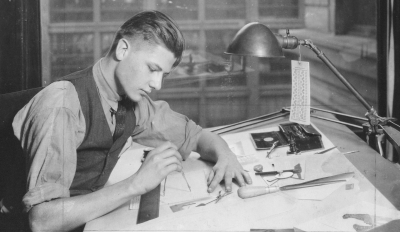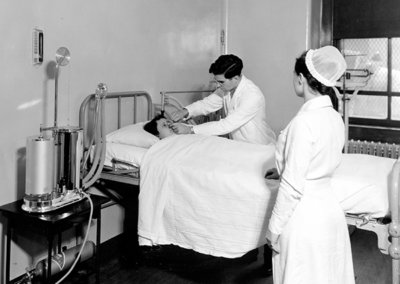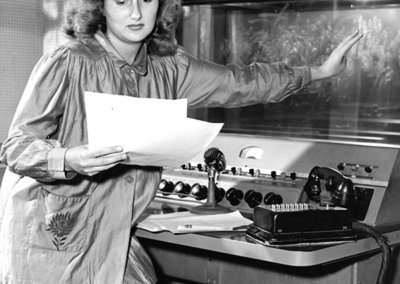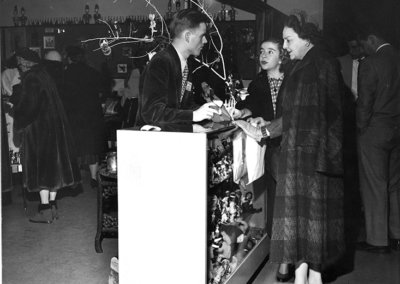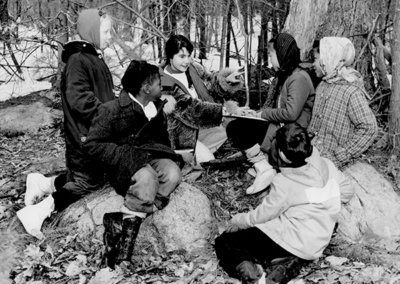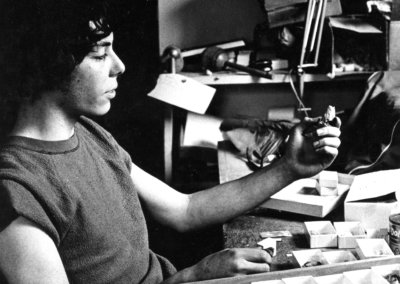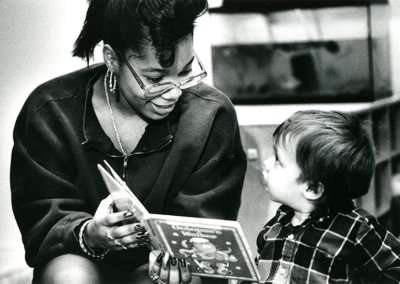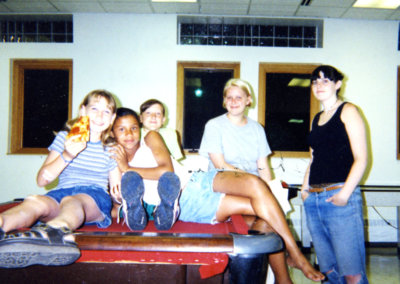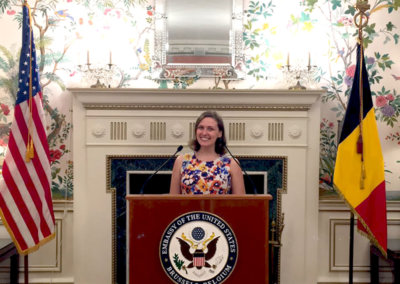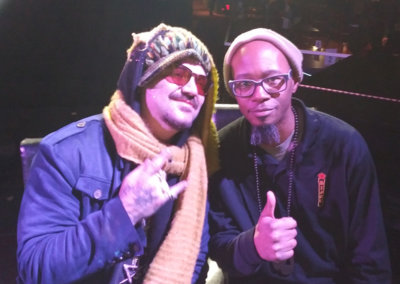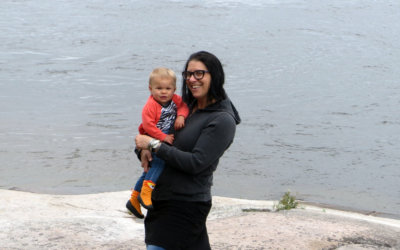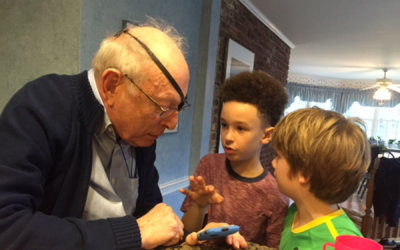Header photo above: Marjorie (Conover) Williams ’34 and Margaret (Watson) Cooper ’36 working behind the sales counter at Rike’s Department Store in Dayton, OH, in 1932
A century of
Cooperative Education
For 100 years, a central component of Antioch’s progressive education model has been its flagship Cooperative Education (Co-op) Program, the first to be established as a core component in an undergraduate liberal arts program.
Co-op provides knowledge and knowhow, which is why generations of Antiochians have had significant impacts in their communities and professions.
While field experience lies at the heart of cooperative education—along with developing a sense of inquiry and reflecting on lessons learned—the Co-op experience transcends its basic tenets of combining classroom-based education with practical work experience. So, as we look back on 100 years—and forward to the next century—the following is a compilation of texts which provide insights into the formation, conceptualization, and application of Co-op at Antioch College.
Antiochians on Co-op
Read more about a century of cooperative education from Antiochians who have lived it in their own words. As we mark a century of cooperative education, we welcome contributions and memories throughout the year.
See Co-op stories from throughout the decades and submit your own.
60 Years After Horace Mann
By Scott Sanders, College Archivist
From “Establishing The Faith,” an essay in Cradles of Conscience: Ohio’s Independent Colleges and Universities, edited by John W. Oliver, James A. Hodges, and James H. O’Donnell, KSU Press, 2003.
By 1919, the Board was strongly considering selling Antioch. The Young Men’s Christian Association, seeking to establish a college of its own, had approached the trustees with a $50,000 pledge to take over the campus. The trustees accepted and even elected a provisional president, YMCA Educational Director Grant Perkins. That they did so on a mere promise of money speaks volumes of their desperate view of the situation.
Unitarian representation on the Board of Trustees had shrunk to one seat by that time, and as the trustees pondered the YMCA offer, that seat came open. The UA in turn appointed its energetic lay vice president, Arthur E. Morgan, to look after its interests. Morgan, a flood-control engineer, was directing the construction of the Miami Conservancy District, a system of earthen dams to solve the Miami Valley‘s chronic flooding problems. A product of the Progressive era, Morgan brought to the job a strong sense of social responsibility, establishing public parks rather than reservoirs behind the dams, and providing permanent low cost housing for construction workers and their families. Morgan also had ideas about education: he wanted young people to get a broad range of instruction in the classroom, but he saw great educational value in real world experience. Morgan himself had never finished high school and attended the University of Colorado for only six weeks, but he had been a logger, a surveyor, and a miner before starting his own engineering company. At the time of his appointment as an Antioch trustee, he and his wife Lucy pondered building a school on a farm they had bought in the Berkshires in Massachusetts—a farm that became the internationally famous school of modern dance Jacob’s Pillow.
The YMCA proposal evaporated once they discovered they were unable to raise the money and complete the sale, and the trustees began to look for a new president. Morgan had proposed an idea he called “industrial education” that afforded students a traditional education in the classroom and experience working in business and industry. Perhaps most importantly for Morgan, through the program’s work component students could earn money to pay for college. It soon became clear to the rest of the Board that Morgan was the best candidate for college president. After much modification by more qualified educators Morgan had hired, his ideas translated eventually into a cooperative plan of alternating work at a job and study on campus. Based on the “Schneider plan” then in place in the University of Cincinnati Engineering Department, the Antioch version applied to the entire curriculum and all majors. Morgan began to aggressively promote “the New Antioch,” and to cultivate the support of industrialists and business leaders. The effort paid off. In 1921 the college reopened to its highest enrollment yet, 203, and by 1927 rose to over 700. The nature of work-study meant that only half of the students were on campus at any one time. Thus the program actually helped to stabilize Antioch’s long precarious finances.
The Reorganization Program for Antioch College
By Arthur E. Morgan (1920)
Known as “The Antioch Plan
The small college cannot duplicate the work of the great universities, but when it recognizes the need for individuality in our educational system, it can find work to do where it will be more effective than the large institutions. Following a survey of the present state of the American small college, the trustees of Antioch have determined upon the reorganization of the college along the following lines:
Student self support by a division of time between college study and remunerative work; the college program being arranged accordingly.
1. A combination of practical experience with academic study, preferably in the calling for which the student is preparing himself.
2. Allowance of credit for actual accomplishment, and not for “clock hours” spent in any given subject. (It is estimated that the average student will require 6 years to complete a course of study requiring full time for 4 years.)
3. The college will offer liberal arts courses and a limited number of technical courses. In the belief that the best results can be secured by a comparatively small faculty of high-grade men and women, the number of regular liberal arts courses will be limited to about 80, which is less than half the number usually offered in small colleges.
4. Except for students who show marked ability in any department, liberal arts courses will deal only with the fundamentals of their subjects. For students who do show such ability, autonomous courses will be provided. That is, for advanced work, well considered courses of study will be offered, with library and laboratory facilities, and with occasional access to the heads of departments or other competent authorities for advice. Thereupon the student will carry the advanced work in the manner of a seminar.
5. There must be coordination between different courses, so that the college will be a synthetic unit, and not an aggregation of unrelated departments, each bidding for the students’ time and interest.
6. A limited number of technical courses will be offered. A technical course must include the fundamentals of a liberal arts education, as it is the aim to make citizens as well as technicians. These courses will aim to develop general competency, rather than highly specialized technique, and to prepare men and women for callings for which adequate preparation is not now being given in colleges and universities. They will aim to make men directors of industry, rather than employees working under detailed directions.
7. The college will aim to eliminate the traditional cleavage between cultural standards and practical standards, and to make practical life for its students a medium of expression for such cultural standards and ideals.
8. Physical fitness is a primary condition to happiness and success. Students will be required to care for their physical condition in order to remain in the institution.
9. The final measure of accomplishment will be the success attained in turning out students whose preparation has laid the basis for productive service, and whose primary aim is service to their communities and to their times. No paper program will accomplish this result, but only the spirit with which the college may be imbued. The chief hope of the trustees is to secure a faculty and a student body that will make this result possible.
The following are selections from the “Details of the Program” section of “The Antioch Plan.”
“Many students work their way through college. With comparatively few exceptions, however, the college does not co-ordinate its work with that of organized industry, but is run for the student who does not have to pay his way. The self-supporting student must do his work at odd hours, usually at common drudgery in competition with lowest paid labor. The Antioch program aims to co-operate with organized industry which has high productive value, and consequently pays high wages, by dividing the student body into 2 groups, each group attending school half time and working half time, in 2-week alternate periods.”
“While Antioch College is located in a quiet village, it is 30 minutes from Springfield on an electric car line, and in the center of one of the greatest industrial districts of the country. Within 30 miles are several hundred highly developed technical industries, several of them the largest of their kind in the world. About 40 of the manufacturers of Springfield have agreed to employ Antioch students. For students in education the adjacent schools offer opportunities for teachers on the co-operative plan, while for students who desire to follow agriculture, farm labor can be secured. It is planned to buy or lease one or more dairy or truck farms to be operated by students under competent direction. Work as carpenters, plumbers, painters, electricians, etc., can be secured by students who qualify in these crafts.”
“Academic study supplies only part of the factors of education. The student does not master his calling until he has practiced it; he does not know what stuff he is made of until he has tried himself out. It is not necessary or desirable for the student to acquire his complete equipment of academic learning before he begins its application. If his work in industry gives meaning and direction to his studies and his studies to his work, his development will be better balanced, and his period of apprenticeship after he leaves school will be shorter.”
“It is the hope of the trustees that little by little the students under proper direction may develop their own industries, such as printing, the operation of a commercial machine shop, farming and contracting. The plans include, also, the construction of a standard factory building on the campus, to be occupied by a number of small industries, chosen because of the educational value of the work, and of the possibility of good wage scales.”
“The content of liberal arts courses should be determined by our best judgment of present values, and not by tradition. Antioch will give more than the traditional weight to subjects that inevitably affect us, and a knowledge of which assists us to direct our lives and our times, and, therefore, proportionally less to others.”
“It is this character of technical and professional training that the Antioch program would provide, and in which it can best compete with the large universities.”
Through combined liberal arts and technical training, “…the student should become a cultural and social asset to his community, as well as an industrial asset.”
The Curriculum in Action
The earliest course catalogues from the 1920s list a range of vocational courses, intended to be about half of a student’s time in the classroom, and within that, “about two thirds would be given to general preparation for management and administration, and about one-third to training for the particular vocation” with the intention that Co-op jobs would provide most of the training through practice. While progressive in many ways, these catalogues are also very much a product of the times.
Five Decades on the Job
Papers from the early 1970s written by longtime Co-op faculty J.D. Dawson and Bob Parker illuminate different challenges and concerns of the time and thinking about the future of cooperative education.
After five decades, the first liberal arts college to integrate cooperative education into its curriculum was still one of the few. “If cooperative education is superior, why is it not more universally used?” wrote Dawson in July, 1972. “Although the general concept of cooperative education now has wide appeal, its implementation has complexities which many institutions are not able to surmount.”
Parker expressed some frustration with the state of affairs at the College in a 1970 paper titled “Where Are We Going?” which covered issues including “lack of time, insufficient personnel, lack of funds, inadequate resources, administrative neglect, faculty apathy, etc.” as well as how the College could “seek to maintain our position as a national leader” in cooperative education.
Parker wrote, “Where are we going? I can’t answer that, nor can any of us. I believe that a major problem facing all of us in the Extramural Department is the absolute inability to see beyond the end of the present day, let alone the end of the current quarter, or year. We seem unable to do much more than carry out our every day tasks, counseling students, advising, visiting employers, or making placements. More particularly we are absolutely unable to find the time for writing, research, or reading related to our professional tasks: the opportunity for scholarly study or professional improvement is non-existent.”
He continued to outline opportunities for the department to be involved more proactively in developing experiential learning opportunities in a variety of programs such as “the Science Institute, the AASI [Afro-American Studies Institute] proposals, the Environmental Studies Center, the new Social Works Program, and Urban Studies Center in Philadelphia, the First Year Program, etc.” Parker further advocated for more involvement in planning and for more resources noting that the 4% of each student’s tuition was applied toward Co-op experiences, while Co-op represented 50% of each student’s program.
Parker’s paper concluded that while overwhelming, the challenges could be handled. “We must create a coherent, cohesive structure in which all of us can participate and be involved to whatever degree we may wish. We need to feel free to throw out ideas and to try them without the fear of failure or destructive criticism. We need to become more supportive of one another, and aware that we are each mutually dependent on the other: we all need to understand that our participation is wanted, needed, and valued. We need to come together, learn to work harmoniously, and begin to take a step at a time.”
Writing more broadly, Dawson’s 1972 paper continued, “Critics of cooperative education point to its over-emphasis on vocational preparation at the expense of more liberally accented education. As one who believes wholeheartedly in a mix of general liberal education for all students, I make no apology for combining this with needed vocational-professional studies and experience. Nothing seems more important to me in education than a program which enables students to get direct experiences with the on-going society, to discover meaningful productive outlets for their purposes and potential, and to gain the kind of preparation which will enable them to live and function effectively in an adult world. Often overlooked is the fact that experience in the working society can add substantially to the student’s liberal education.
“The public, as typified by school counselors and parents among others, often views the cooperative plan merely as a means of financial assistance—important as this aspect is for many students. We have yet to achieve widespread public understanding of cooperative education in the qualitative sense, as it can affect the self-development of students, the teaching styles of faculty, the character of a college, and the interface relations with business, industrial, and social institutions.
“If colleges really believe that non-academic experience should become an integral part of teaching-learning, student self development and educational preparation, they will incorporate it in the degree requirement.”
Antioch College Works
In 2020, experiential education remains at the heart of an Antioch College education. The lessons learned from Co-op over decades have continually been honed and reapplied to the curriculum.
“Every single class that I teach here has a hands-on experiential component,” says Associate Professor of Biology and Environmental Science Kim Landsbergen. “I’m really trying to help students understand that in taking these subjects they’re building their skills. But it’s just like being a musician. I can show you a few chords in class, but unless you go practice you’re not going to really become an expert in that area. So these courses tend to be a way of introducing students to these subjects, and if they’re excited about it maybe they can find a Co-op that allows them to spend three months really getting into it. Our curriculum encourages that scaffolded learning in that way.”
“The Co-op faculty operates with a deep appreciation of the array of student experiences that have been realized over the course of the last century, says Dean of Cooperative, Experiential and International Education Rick Kraince. “Our objective as the College earned its independence was to live up the expectations of our devoted alumni base while also meeting student aspirations in the present. We frequently reflect on the Report on the Carnegie study of the Antioch Educational Program that was published in 1960. The report’s authors convey that while ‘work for pay’ has always been an important element, the off-campus educational experiences that constitute Co-op have long included “foreign experience (work, study, or travel), uncompensated service projects (work camps, internships in community service), a period of independent writing or study (including a senior independent study period), an assignment in a research institution (paid or unpaid), a period in a specialized technical school (arts school, medical technology school), or any other experience approved in advance by the appropriate faculty as an appropriate medium for complementing the student’s learning opportunities on campus. With nearly 1,300 Co-op placements in 36 countries over the course of the last eight years, I feel we have shown that Co-op students presently are as ingenious, industrious, and intrepid as ever.”
Following the newly independent College’s accreditation, the faculty sought to push the boundaries of Antioch’s core strengths and traditions even further with a new action-oriented curriculum built around experiential education and the applied liberal arts.
Assistant Professor of Cooperative Education Luisa Bieri notes how the curriculum empowers students to be actively involved in creating their education, and to be the change-agents they want to be in the world. And Co-op is key to this experience, “We have students working at foundations, nonprofits, successful businesses and companies, and looking at what that feels like out in the world—being a part of a real team, making purposeful projects come to reality,” says Bieri.
The College recently took additional steps to build on the strength of Co-op, and its legacy of a laboratory college where students learn by doing, with the Antioch College Works (ACW) program. Students are now guaranteed work during regular study terms on campus or in the community in addition to Co-op as part of ACW, and an international work experience. The ACW program also introduced the “launch Co-op” which provides meaningful, compensated placement for students who aren’t enrolled in graduate school or employed after earning their bachelor’s degree. Further, ACW addresses the affordability, accessibility, and value of the applied liberal arts with a program providing guaranteed full-tuition scholarships to Pell-eligible students and meeting the financial need of all students.
“The students who have chosen to attend Antioch recognize the distinctive choice it offers them,” says President Tom Manley. “They are drawn to a college that lives actively in life-realities rather than constructing a retreat from them. They are attracted to collaboration with teachers and mentors to own their education, to learn experientially, and to find ways to apply that learning in service to others. Our students want and need a college that works.”
Published in the Fall 2020 issue of The Antiochian, a magazine for alumni and friends of Antioch College.



